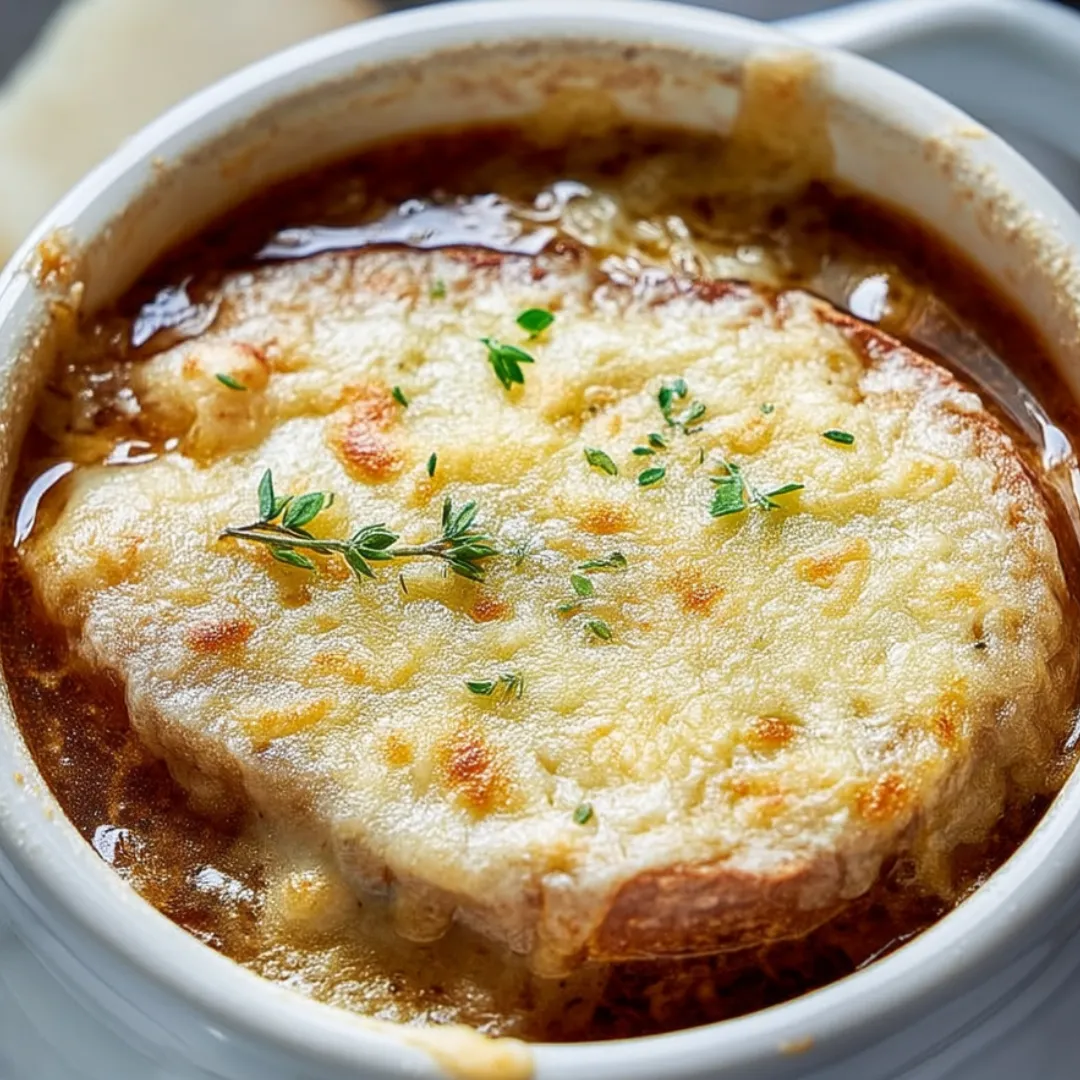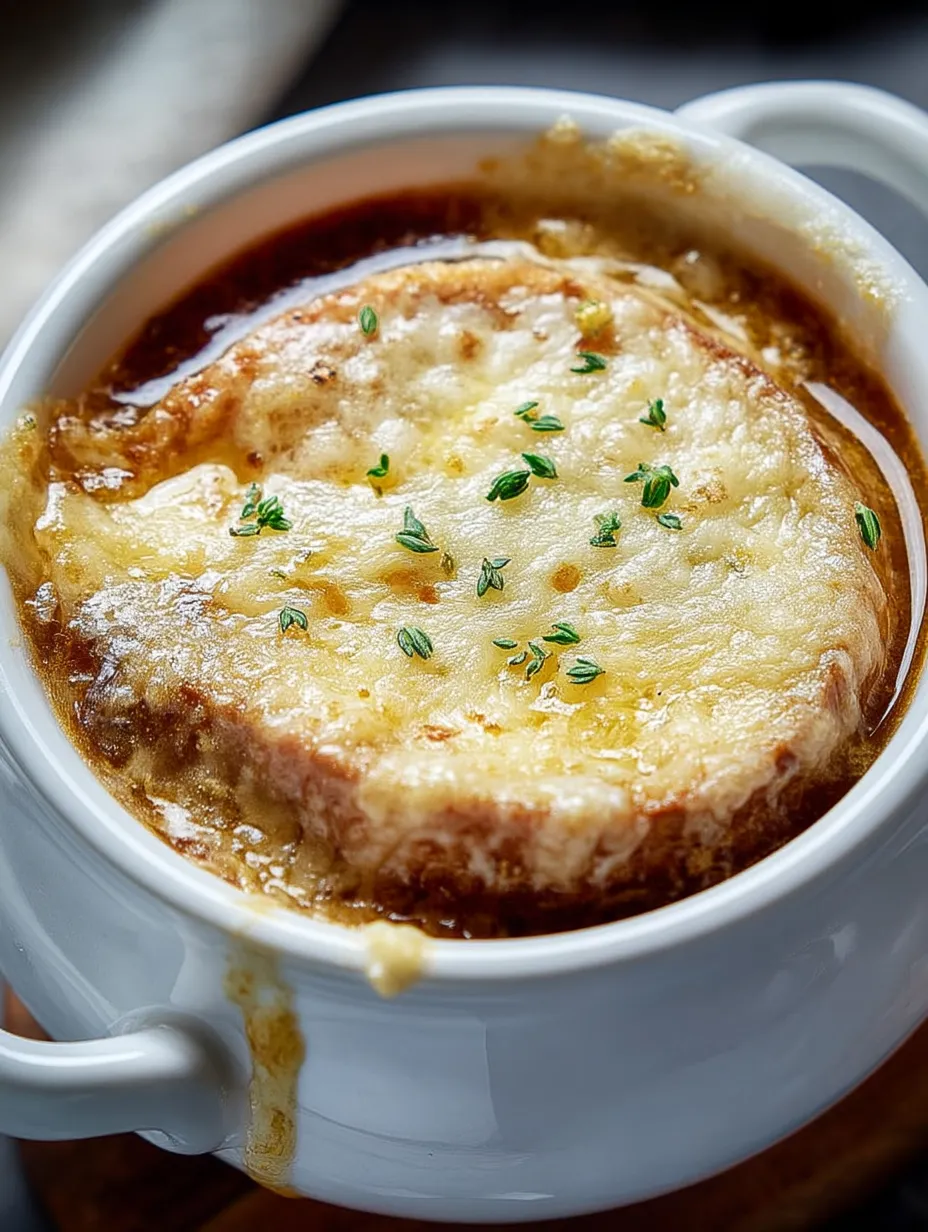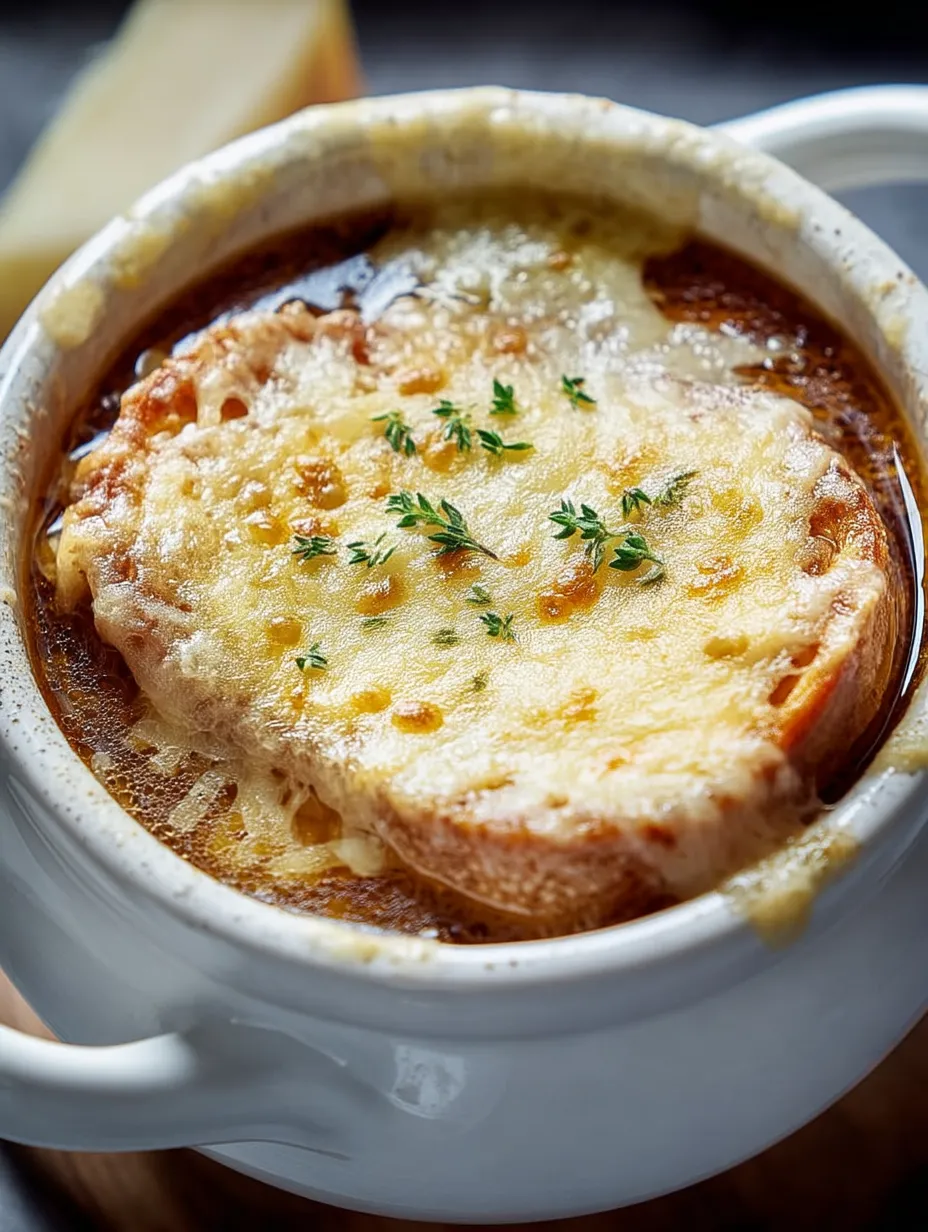 Pin it
Pin it
This classic French Onion Soup transforms humble ingredients into something truly magical. The sweet depth of caramelized onions swimming in rich, savory broth creates a foundation for that signature cheese-crusted bread topping that bubbles and browns to perfection. After years of tweaking this recipe, I've found the perfect balance of simplicity and flavor that delivers restaurant-quality results from your home kitchen.
The first time I made this soup, I was skeptical that something with so few ingredients could taste so complex. I invited friends over for dinner, nervous about serving something so simple, but watched in delight as everyone fell silent, focused entirely on savoring each spoonful. One friend looked up with wide eyes and asked if I'd been secretly taking cooking classes! That moment convinced me this humble soup deserves its legendary status.
Ingredients
- 4 large onions: The foundation of this soup, providing both structure and flavor. Look for firm, heavy onions with shiny, crackly skin and no soft spots. Yellow onions provide the perfect balance of sweetness and savory flavor when caramelized, though Vidalia or white onions work beautifully too. Slice them thinly and uniformly for even cooking.
- 3 tablespoons butter: Creates richness and helps onions caramelize properly. European-style butter with higher fat content produces deeper flavor, but any good quality butter works well. The butter should be cold when added to the pot, as it will melt slowly and coat the onions evenly.
- 1 tablespoon olive oil: Prevents butter from burning during the long caramelization process. Choose a good quality but not necessarily premium oil since its subtle flavors will blend with the stronger elements in the soup. The oil should have a clean, fresh aroma without any rancid notes.
- 1 teaspoon sugar: Helps jump-start the caramelization process. Regular granulated sugar works perfectly - no need for anything fancy. This small amount enhances the onions' natural sweetness without making the soup actually sweet.
- 2 cloves garlic, minced: Adds a subtle depth that complements the onions. Look for firm, tight heads of garlic with papery skin intact. Fresh garlic should feel heavy for its size and have no green sprouts (which indicate age and bitterness).
- 6 cups beef broth: Provides the savory backbone of the soup. Homemade stock creates exceptional flavor, but a good quality store-bought broth works well too. For the richest flavor, choose beef broth with visible fat droplets on the surface and a deep amber color.
- 1 teaspoon Worcestershire sauce: Adds umami depth and subtle tanginess. Look for brands with natural ingredients rather than artificial colors or flavors. The sauce should have a complex aroma with hints of tamarind, molasses, and spices.
- 1/2 teaspoon dried thyme: Contributes an earthy, herbaceous note. Quality dried thyme should still have a strong aroma when crushed between your fingers. Store in a cool, dark place to preserve its essential oils.
- Salt and pepper: Enhances all other flavors. Kosher or sea salt provides cleaner flavor than iodized table salt. Freshly ground black pepper delivers significantly more aroma and complexity than pre-ground.
- 1 baguette: Creates the perfect vessel for soaking up broth while providing textural contrast. Look for a baguette with a crackling crust and light, airy interior. Day-old bread actually works better here as it toasts more effectively without becoming soggy.
- 2 cups shredded Gruyère cheese: Forms that irresistible melty, browned topping. Authentic Gruyère has a nutty, slightly sweet flavor that becomes more complex when melted. Younger Gruyère (aged 3-5 months) melts more smoothly than aged varieties, making it ideal for this application.
 Pin it
Pin it
Step-by-Step Instructions
- Step 1:
- Begin the caramelization process thoughtfully - Set a heavy-bottomed Dutch oven or large pot over medium heat and add the butter and olive oil. Watch carefully as the butter melts completely, swirling occasionally to combine with the oil. This combination gives you the best of both worlds - the flavor of butter with the higher smoke point of oil to prevent burning during the long cooking process. Once the mixture is hot but not smoking, add all your thinly sliced onions at once. They will fill the pot dramatically, but don't worry - they'll cook down to about a quarter of their original volume. Stir thoroughly to coat every sliver of onion with the fat, ensuring they'll cook evenly and develop that beautiful golden color uniformly.
- Step 2:
- Master the art of patient caramelization - Reduce the heat to medium-low and prepare for the most important part of French onion soup - properly caramelizing the onions. This isn't a process you can rush. For the first 10 minutes, stir occasionally as the onions begin to soften and become translucent. You'll notice they start to release their moisture and shrink considerably. After about 15 minutes, sprinkle the teaspoon of sugar evenly across the onions and stir to incorporate. This small amount of sugar helps kick-start the caramelization process without making the soup sweet. Now comes the true test of patience - continue cooking for another 25-30 minutes, stirring every few minutes to prevent sticking and ensure even browning. Watch as the onions transform from white to translucent to golden to a rich amber brown. You're looking for a deep caramel color with no burnt bits. If onions start to stick too much, add a tablespoon of water and scrape up the flavorful bits from the bottom. This slow process develops the complex sweetness that forms the soul of French onion soup.
- Step 3:
- Develop the aromatic foundation - Once your onions have reached that perfect deep amber color, it's time to add the garlic. Reduce the heat to low and add the minced garlic, stirring constantly for exactly one minute. This brief cooking time mellows garlic's sharpness while releasing its aromatic compounds without risking any bitterness from burning. You'll know it's ready when the kitchen fills with that irresistible garlic fragrance. This step creates an aromatic foundation that supports the sweet onions and savory broth.
- Step 4:
- Create a flavor-packed broth - Now pour in the beef broth in a steady stream while stirring continuously to incorporate all the caramelized bits from the bottom of the pot - these contain concentrated flavor you definitely don't want to leave behind. Add the Worcestershire sauce and dried thyme, crushing the thyme slightly between your fingers as you add it to release more of its essential oils. Increase the heat and bring the mixture to a gentle boil, then immediately reduce to a simmer. This initial boil helps the flavors start to meld before the gentler simmering phase. Cover the pot partially with a lid, allowing some steam to escape while keeping most of the heat in. Let the soup simmer for 20-25 minutes, occasionally stirring and tasting. During this time, the broth absorbs the sweet complexity from the onions while the onions soak up the savory richness of the broth, creating that perfect harmony of flavors.
- Step 5:
- Balance the seasoning perfectly - After simmering, it's time for the crucial step of seasoning. Add salt and freshly ground black pepper gradually, tasting after each addition. Remember that the cheese will add saltiness later, so be careful not to over-salt. The exact amount needed depends on the saltiness of your broth and your personal preference. A properly seasoned soup should taste rich and flavorful, not obviously salty. The pepper adds a subtle warmth rather than heat. Let the soup simmer for another 5 minutes after seasoning to fully integrate the flavors. At this point, your soup base is complete - richly flavored, perfectly balanced, with tender, sweet onions throughout.
- Step 6:
- Prepare the critical bread component - While the soup completes its final simmer, preheat your oven to 375°F (190°C). Slice the baguette into rounds about 1/2-inch thick - not too thin or they'll disintegrate in the soup, not too thick or they'll be unwieldy to eat. Arrange the slices on a baking sheet in a single layer without overlapping. Toast them in the preheated oven for 5-7 minutes on each side until they're golden and crisp throughout. You want them thoroughly dried out, almost like large croutons, so they can absorb some broth without falling apart. The contrast between the crusty bread and the soup is a signature element of authentic French onion soup.
- Step 7:
- Shred the cheese properly - While the bread toasts, prepare your cheese. For the best melt and flavor, always shred cheese fresh rather than buying pre-shredded. The anti-caking agents in packaged shredded cheese can prevent smooth melting. Using the large holes of a box grater, shred the Gruyère into a bowl. Room temperature cheese melts more evenly, so if you've just taken it from the refrigerator, let it sit for about 15 minutes before shredding. The ideal shred is not too fine (which can cause clumping) or too coarse (which won't melt properly).
- Step 8:
- Assemble with care for the perfect presentation - Once your soup is seasoned to perfection, preheat your broiler to high. Ladle the hot soup into individual oven-safe crocks or bowls, filling them about 3/4 full. The traditional French onion soup bowls are wide and shallow, which provides maximum surface area for that glorious cheese topping, but any oven-safe bowl will work. Place one or two toasted baguette slices on top of each bowl of soup, allowing them to float on the surface. It's fine if they absorb some broth - that's part of the experience. Now generously cover the bread and any exposed soup with the shredded Gruyère, extending it all the way to the edges of the bowl where it will create those irresistible crispy cheese bits.
- Step 9:
- Achieve the perfect golden cheese crust - Place the filled bowls on a baking sheet (to catch any potential overflow) and carefully transfer to the oven, positioning the sheet about 6 inches below the broiler. Watch attentively as the cheese melts, bubbles, and then begins to develop brown spots. This usually takes 2-4 minutes depending on your broiler's strength. The perfect finish has the cheese completely melted with patches of golden-brown caramelization. Don't walk away during this process - the difference between perfectly browned and burnt happens in seconds! The result should be a beautiful bubbling surface with areas of deeper caramelization that add visual appeal and flavor complexity.
- Step 10:
- Serve with the right timing and temperature - Using heat-resistant mitts, carefully remove the baking sheet from the oven. The bowls will be extremely hot, so transfer them to heatproof plates or chargers. Allow the soup to cool for about 2-3 minutes before serving - this prevents burnt tongues while keeping the soup hot enough to enjoy properly. The ideal serving temperature lets you appreciate the flavors fully while the cheese remains stretchy and the bread maintains some structure. Serve with soup spoons and, ideally, small knives to help cut through the cheese and bread. The perfect bite includes a little bit of everything - the sweet, savory broth, tender onions, soaked bread, and that glorious cheese crust.
When served, the contrast between the golden, bubbling cheese topping and the rich, dark soup beneath creates an irresistible presentation that promises comfort and satisfaction in every spoonful.
A French Classic With Humble Origins
French onion soup represents everything I love about great cooking - taking humble, inexpensive ingredients and transforming them through technique and time into something extraordinary. This peasant dish originated centuries ago in France when onions were plentiful, affordable, and stored well through winter months when fresh produce was scarce.
What fascinates me about this recipe is how the patient caramelization process fundamentally transforms onions from sharp and pungent to meltingly sweet and complex. The chemistry happening in your pot is remarkable - the natural sugars in the onions are breaking down and creating hundreds of new flavor compounds that simply didn't exist before.
I've served this soup at everything from casual family dinners to elegant dinner parties, and it never fails to impress. There's something magical about breaking through that cheese crust for the first time, watching the steam escape, and then taking that perfect spoonful that combines all the elements. Even my friend who claimed to dislike onions found herself asking for seconds after I convinced her to try just one bite.
Perfect Pairings and Serving Suggestions
While this soup is satisfying enough to serve as a light meal on its own, I've discovered several pairings that create a more complete dining experience. For a classic French bistro meal, serve smaller portions as a starter before a simple roast chicken or steak with green beans. The rich soup prepares the palate beautifully for the main course.
For a casual lunch, I often serve a bowl of this soup with a simple green salad dressed in a sharp vinaigrette. The bright acidity of the salad provides the perfect counterpoint to the soup's richness. A glass of dry red wine, particularly a French Côtes du Rhône or Bordeaux, complements the caramelized flavors wonderfully.
On particularly cold evenings, I've found that turning this into a more substantial meal works beautifully. Adding a poached egg to the top of the cheesy crust just before serving creates an even more luxurious experience as the yolk breaks and enriches the broth. Another variation I love is adding thinly sliced mushrooms to the onions during the last 10 minutes of caramelization, which adds an earthy depth to the flavor profile.
For entertaining, I sometimes prepare the soup base a day ahead, which not only saves time but actually improves the flavor as the ingredients have more time to meld. I simply reheat the soup and proceed with the bread and cheese topping just before serving, which creates an impressive presentation with minimal last-minute effort.
I discovered the importance of proper onion slicing technique during a cooking class in Paris. The chef demonstrated how slicing onions pole-to-pole (from root to stem) rather than across the equator results in slices that hold their shape better during long cooking. This seemingly small detail makes a noticeable difference in the final texture of the soup. When I returned home and made the recipe his way, my family immediately commented on how the soup seemed more "authentic" without knowing what I'd changed.
 Pin it
Pin it
The Art of Cheese Selection
While traditional French onion soup calls specifically for Gruyère, I've experimented with numerous cheese variations over the years with fascinating results. The perfect cheese for this soup needs three qualities: excellent meltability, enough flavor to stand up to the rich broth, and the ability to form a beautiful golden crust under the broiler.
For a slightly sharper flavor profile, I've had great success using a combination of Gruyère and aged white cheddar in equal proportions. The cheddar adds a pleasant tanginess that contrasts beautifully with the sweet onions. For a milder, creamier approach, combining Gruyère with fontina creates a lusciously smooth topping that stretches impressively with each spoonful.
For those who prefer a more pronounced flavor, a mixture of Gruyère and blue cheese (using about 1/4 blue to 3/4 Gruyère) creates a bold variation that pairs exceptionally well with a glass of robust red wine. The blue cheese adds unexpected complexity without overwhelming the soup's essential character.
I've even created a Mediterranean-inspired version using a combination of mozzarella for meltability and Parmesan for flavor, then finishing with a sprinkle of fresh thyme leaves after broiling. While purists might raise an eyebrow, this variation has become a requested favorite among my friends who prefer Italian flavors.
Over years of making this soup, I've developed a deep appreciation for how something so simple can bring such comfort. There's a meditative quality to the process of slowly caramelizing onions, watching their transformation while the kitchen fills with increasingly complex aromas. What begins as a sharp, eye-watering scent gradually mellows into something sweet and nutty that draws everyone to the kitchen asking when dinner will be ready. This soup isn't just about feeding people; it's about creating an experience that engages all the senses and transforms an ordinary evening into something special. Even now, when I serve it to guests who have never tried homemade French onion soup before, I love watching their expressions change from curiosity to delight with that first perfect spoonful.
Frequently Asked Questions
- → Can I make French onion soup ahead of time?
- Yes! The soup base (without bread and cheese) can be made 2-3 days ahead and refrigerated. It actually improves with time as flavors meld. Just reheat and add the bread and cheese toppings before serving.
- → Can I freeze French onion soup?
- Absolutely. Freeze only the soup base without the bread and cheese. It freezes well for up to 3 months. Thaw overnight in the refrigerator, then reheat and add the toppings before serving.
- → How can I make this vegetarian?
- Simply substitute vegetable broth for the beef broth and check that your Worcestershire sauce is vegetarian (some contain anchovies). The soup will have a lighter color but still be delicious.
- → Why aren't my onions caramelizing properly?
- Caramelizing onions takes patience! Don't rush the process by using high heat. Keep the heat medium to medium-low, and don't stir too frequently. It should take about 30 minutes for properly deep caramelization.
- → What can I serve with French onion soup?
- This soup is hearty enough to be a meal on its own, but pairs wonderfully with a simple green salad dressed with vinaigrette. For a more substantial meal, serve with a crusty baguette and a glass of red wine.
